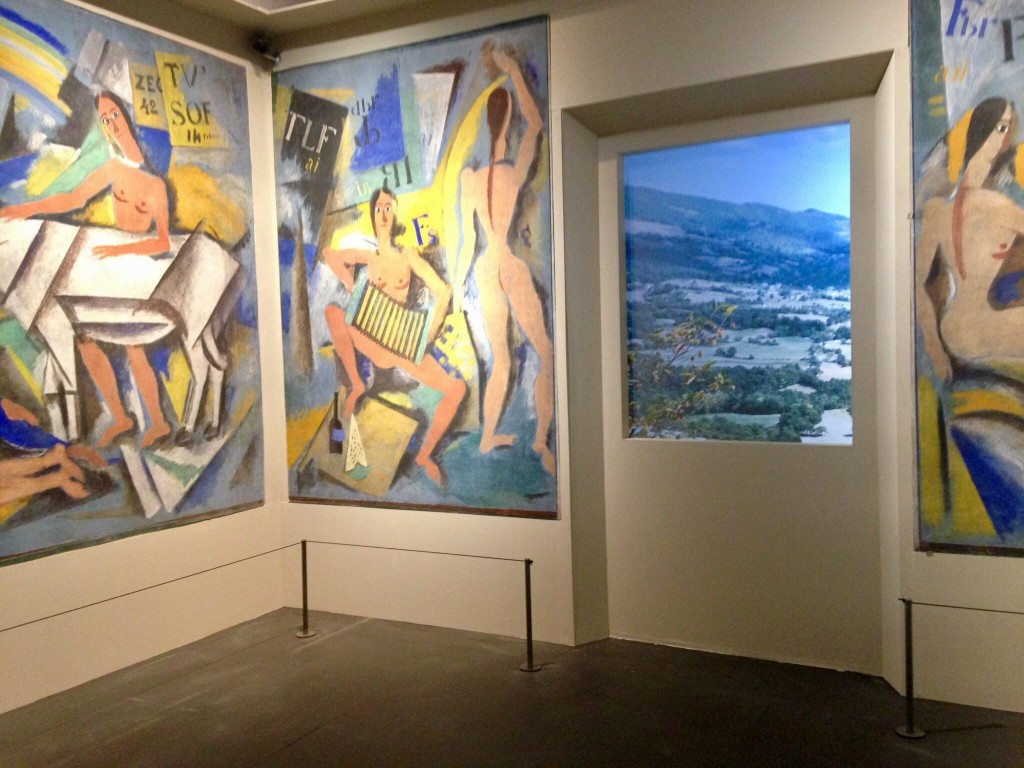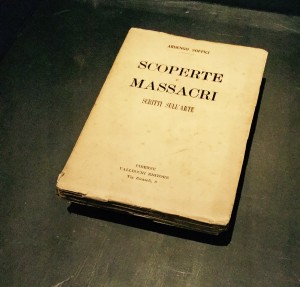Galleria degli Uffizi, dal 27 settembre all’8 gennaio 2017.
Di Maria Eletta Benedetti (Università di Firenze)
Allestita nelle sale per esposizioni temporanee della Galleria degli Uffizi la mostra dedicata alla poliedrica figura di Soffici (1879-1964) si apre a sua volta con la mostra la Festa dell’Arte e dei Fiori del 1896-1897, che colpì il giovane Ardengo. Questa seconda mostra (nella mostra) introduce in un viaggio nel tempo e in un’Italia in trasformazione a cavallo tra la fine dell’Ottocento e la Grande Guerra.
Sin dalla prima sala, così come in tutto il percorso successivo, è come se Soffici prendesse per mano e conducesse il visitatore alla scoperta degli artisti e dei luoghi che lo hanno colpito e interessato nella sua esperienza di letterato, pittore e intellettuale. Nei pannelli infatti la didascalia dell’opera è accompagnata da un commento storico-critico e dalle parole di Soffici recuperate dai suoi saggi, lettere e articoli. I suoi giudizi e le sue descrizioni risuonano protagoniste insieme alle numerose opere esposte di molti altri artisti oltre a quelle di Soffici, che il visitatore può osservare da un punto di vista originale e personale, accompagnato cioè dai commenti e dalle spiegazioni nei pannelli della poliedrica figura dello stesso Ardengo. Le opere esposte aiutano quindi a ripercorrere visivamente il percorso artistico di Soffici e proprio per questo motivo non sono presenti solo opere del protagonista, ma insieme a lui come co-protagonisti le grandi personalità di fine Ottocento- inizi Novecento.
L’illuminazione è ben pensata e focalizza l’attenzione dell’osservatore sui quadri e sulle sculture esposte all’interno delle sale di colore scuro. I pannelli esplicativi, posti all’ingresso di ogni ambiente, sono brevi ma utili per contestualizzare la peculiarità delle varie sale.
Il viaggio inizia con Segantini e termina con l’autoritratto di Soffici del 1949. Questo quadro è più che mai importante dal momento che, donato dagli eredi alla Galleria degli Uffizi, è stato il pretesto e l’occasione della mostra. Al volto maturo di Soffici è affiancato Scoperte e massacri, scritti sull’arte (1919), il saggio dell’autore che è stato in parte guida per la realizzazione della mostra e ne ha ispirato il titolo. Gli interessi così come i “massacri” di Soffici sono mostrati con la stessa criticità dell’intellettuale, maturata nel tempo dopo un viaggio a Parigi nel 1900. Soffici scopre i grandi artisti a lui contemporanei e li racconta in questa mostra, nella quale si possono incontrare tele di Cézanne e Henri Rousseau, sculture di Medardo Rosso, provocazioni dei Futuristi, quadri dei maggiori esponenti della rivoluzione cubista, primo tra tutti Picasso, amico di Soffici. Le esperienze artistiche che Soffici conosce vengono raccontate da lui stesso ne La Voce, rivista fondata nel 1908 da Prezzolini e da Papini, poi nel periodico Lacerba e dopo la Prima Guerra Mondiale in Valori Plastici. Esposti agli Uffizi sono presenti anche quadri dello stesso Soffici, che narra e sperimenta con il pennello le amicizie e gli stili dei grandi pittori d’avanguardia del Primo Novecento, che influenzarono non solo il protagonista della mostra ma anche la cultura italiana del tempo.
Spartiacque nella vita e nello stile di Soffici è la guerra, che lo vede in prima linea come promotore e soldato volontario, ma anche come narratore insieme a De Chirico e Carrà. A metà del percorso espositivo il visitatore si ferma e può guardare un video che riassumendo le sale appena visitate introduce, con le parole dello stesso letterato, alle ultime sale dedicate appunto al cambiamento di Soffici di ritorno dalla Grande Guerra. Nella sala affianco alla proiezione è assai interessante la ricostruzione dei pannelli decorativi per la “stanza dei manichini” per la casa di Papini a Bulciano.
Dopo la guerra Ardengo Soffici è cambiato, così come l’Italia. Dopo le sperimentazioni avanguardiste Soffici cerca una nuova “scoperta”, un nuovo punto da cui ripartire artisticamente (come si può vedere dall’ultima sala con alcune Nature morte). E così anche Soffici, come molti altri artisti del tempo, fa “ritorno all’ordine”.
Lo scopo della mostra è quello di spiegare attraverso il percorso artistico di Soffici il cambiamento d’epoca che porterà alle novità artistiche del XX secolo. Grazie a questa scelta espositiva il visitatore può rivivere i fermenti culturali delle Avanguardie Storiche e l’esperienza sofficiana tanto da poter lasciare la Galleria degli Uffizi conoscendo un po’ di più l’uomo autoritratto alla fine della mostra.
Galleria degli Uffizi, 27 September 2016 to 8 January 2017
Translation by Rachyl Grussing
Staged in the temporary exhibition rooms of the Uffizi Gallery is a show dedicated to the multifaceted figure of Ardengo Soffici (1879-1964). The show opens with The Festival of Flowers,1896-1897, which struck the young Ardengo. The second show in the exhibition introduces themes of a journey in time and an Italy in transformation, situated in between the end of the 19th century and the Great War.
From the first room, as well as all rooms throughout, it is as if Soffici takes the hand of the visitor to discover the artists and the places that have affected and interested his experience as writer, painter and intellectual. In fact, the work of the panels is accompanied by a historical-critical commentary and words of Soffici, recovered from his essays, letters, and articles. His judgements and his descriptions resonate together with numerous provocative works exhibited by many other artists, as well as those by Soffici. Visitors can observe from an original and personal point of view that is accompanied by commentary and explanations in the panels by the multifaceted figure of Soffici. The exhibited works help to visually retrace the path of the artist and, for this reason, not only are works of other artists present, but together with Soffici being co-artist of the great personalities of the late Nineteenth and early Twentieth centuries.
The lighting is well thought out and focuses the attention of the observer on the paintings and the sculptures displayed in the dark colored rooms. The explanatory panels, placed at the entrance of each room, are short but useful to contextualize the peculiarities in the various rooms.
The journey begins with Segantini and finishes with the self-portrait of Soffici from 1949. This painting is more important than ever since its donation to the Uffizi Gallery by his heirs was the pretext and occasion for the exhibition. The mature face of Soffici accompanies Discoveries and Massacres, writings of the artist (1919), the artists essays that were in part a guide for the realization of the show and the inspiration for the title. The interests and the ‘massacres’ of Soffici are shown with the same intellectual criticality, matured over time after a trip to Paris in 1900. Soffici discovered the great artists of his time and recounts them in this exhibition, where you can meet paintings by Cezanne and Henri Rousseau, sculptures by Medardo Rosso, provocations by the Futurists, Cubist paintings by the major representatives, and first of all the works by Picasso, a friend of Soffici. The artistic experiences that Soffici knew are told by himself in The Voice, a magazine founded in 1908 by Prezzolini and Papini, then periodically in Lacerba, and after the first World War in Plastic Valor. Exhibited at the Uffizi are also paintings by Soffici narrating friendships and experimenting with the brush the styles of the great avant garde painters of the Nineteenth century, who influenced not only the main protagonist of the exhibition, but all Italian culture during the time.
A watershed moment in the life and style of Soffici is the war, in which he is at the forefront as promoter and volunteer soldier, but also as a storyteller with De Chirico and Carra. Halfway through the exhibition the visitor can stop and watch a video summarizing and introducing the halls just visited, with the same words and letters. The last rooms are dedicated to the change within Soffici and his return from the Great War. In the room next to the presentation is a very interesting reconstruction of the decorative panels for the ‘Mannequin Room’ for the house of Papini and Bulciano.
After the war Ardengo Soffici was changed, as was Italy. After the experimentation with avant garde, Soffici searched for a new ‘discovery’, a new point from which to start artistically (as you can see from the last room with the Still Life). And so even Soffici, like many other artists of the time, does a ‘return to order’.
The purpose of the exhibition is to explain, through the artistic career of Soffici, the change of era which will bring the new art of the 20th century. Thanks to this choice of exhibition, the visitor can relive the cultural fermentation of the avant garde history as experience by Soffici, enough to leave the Uffizi Gallery knowing a little more about the man in the final self-portrait of the exhibition.

